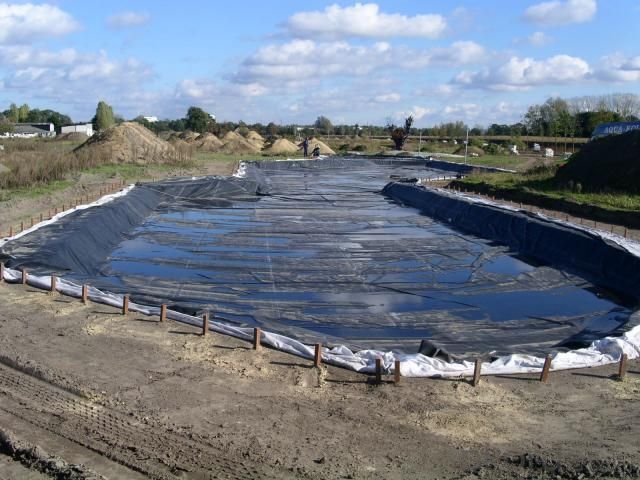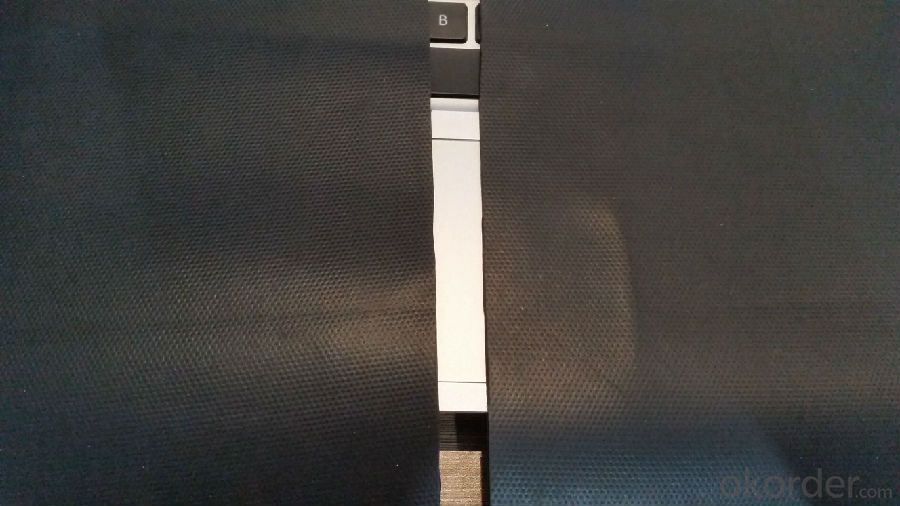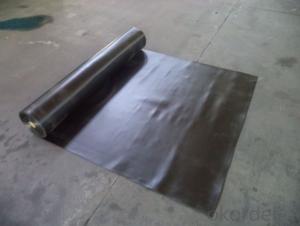EPDM Waterproof Weldable Membrane with 1.5mm Thickness
- Loading Port:
- Shanghai
- Payment Terms:
- TT OR LC
- Min Order Qty:
- 20000 m²
- Supply Capability:
- 5000000 m²/month
OKorder Service Pledge
OKorder Financial Service
You Might Also Like
EPDM Waterproof Weldable Membrane with 1.5mm Thickness
Description Of EPDM Waterproof Weldable Membrane with 1.5mm Thickness:
1. EPDM waterproof membrane is made from ternary ethylene-propylene rubber, which is for waterproofing of exposed and non-exposed applications.
2. EPDM waterproof membrane production adopts the world-advanced equipment of cold feeding extrusion and continuous vulcanization technology.
3. EPDM waterproof membrane is of high elasticity among high polymer waterproof materials and becomes a world-popular waterproofing material.
Main Features of EPDM Waterproof Weldable Membrane with 1.5mm Thickness:
1.Excellent anti-aging performance, service life can reach 50 years;
2.High elongation, high tensile strength, heat treatment size change small;
3.Plant root penetration resistance is good
4.Good low temperature flexibility
5.Application is convenient, overlapping is firm and reliable, no environmental pollution;
6. Resistance to chemical corrosion, can be applied to special places;
7.Maintenance is convenient, the cost is low
Specifications of EPDM Waterproof Weldable Membrane with 1.5mm Thickness:
ITEM | STANDARO REQUEST | |
Tensile strength at breaking,normal temperature,Mpa | ≥7.5 | |
Elongation at breaking, % | ≥450 | |
Tearing strenght,KN/m | ≥25 | |
Bending at low temperature | ≤-40°C | |
Water impermeability,0.1Mpa×30min | Impermeability | |
Hot air aging 80°C×168h | Unchanging of tensile strength at breaking,% | ≥80 |
Unchanging of elongation at breaking,% | ≥70 | |
Appearance of 100% elongation | No crack | |
Property of anti alkali 10% Ca(OH)2×168h normal temperature | ≥80 | |
≥80 | ||
Applications of EPDM Waterproof Weldable Membrane with 1.5mm Thickness:
1.Roofs, Basement, Toilets
2. Industrial and civil building waterproofing
3. Geosynthetic liner for swimming pool, channels, irrigation system
4. Especially suitable for projects with high requirements in durability, anti-corrosion and deformation.



IMages of EPDM Waterproof Weldable Membrane with 1.5mm Thickness:




FAQ of EPDM Waterproof Weldable Membrane with 1.5mm Thickness:
1. What are we supplying?
We are specialized in producing Colorful Asphalt Roof Shingle, SBS/APP modified bitumen waterproof membrane, Self adhesive bitumen waterproof membrane, PVC waterproofing membrane, EPDM rubber roofing membrane, Single Component Polyurethane Waterproof Coating, and Spray Polyurea Waterproof Coating
.
2. How Many years experience do we have?
We have been exported to more than 20 countries in the past 15 years.
3. How long do we usually reply your request?
We always reply our customer within 24 hours.
- Q:SBS Shale Waterproof Coil
- SBS modified asphalt waterproofing membrane, this coil has a good high temperature performance, can be -25 to +100 ℃ temperature range of use, a higher flexibility and fatigue resistance, and up to 1500% Elongation and strong puncture resistance, tear resistance. Suitable for cold areas, as well as deformation and vibration of large industrial and civil buildings waterproofing works.
- Q:Can a waterproofing membrane be used in ponds or reservoirs?
- Yes, a waterproofing membrane can be used in ponds or reservoirs. Waterproofing membranes are designed to create a barrier that prevents water from seeping through, making them an effective solution for creating a watertight seal in ponds or reservoirs.
- Q:Is a waterproofing membrane resistant to extreme weather conditions?
- Yes, a waterproofing membrane is designed to be resistant to extreme weather conditions. It provides a protective barrier against heavy rain, snow, and intense sunlight, ensuring that it remains intact and effective in preventing water infiltration and damage to the underlying structure.
- Q:Is a waterproofing membrane resistant to UV rays?
- Yes, a waterproofing membrane can be resistant to UV rays. Many waterproofing membranes are designed and manufactured with additives that provide protection against UV rays. These additives help to prevent the membrane from degrading and losing its waterproofing properties when exposed to sunlight. UV resistance is an important feature in waterproofing membranes, especially for applications where the membrane will be exposed to direct sunlight for extended periods of time, such as on rooftops or outdoor structures. However, it is important to note that the level of UV resistance can vary depending on the specific type and brand of waterproofing membrane. Therefore, it is always recommended to check the product specifications and consult with the manufacturer to ensure that the chosen membrane offers the desired level of UV resistance for the intended application.
- Q:1.2 thick synthetic polymer waterproofing membrane two weight how to count
- Waterproof to do in what position, the specific requirements, you can contact me, I have a contact in space, the specific use of what materials, synthetic polymer points several categories, the same material is not the same cost
- Q:Can a waterproofing membrane be recycled or disposed of in an environmentally friendly manner?
- Yes, a waterproofing membrane can be recycled or disposed of in an environmentally friendly manner. Many waterproofing membranes are made from recyclable materials such as rubber, PVC, or polyethylene. These materials can be recycled through specialized facilities that process them into new products. Additionally, some waterproofing membranes are biodegradable, meaning they can naturally decompose over time without harming the environment. It is important to check the specific type of membrane and consult with local recycling centers or waste management facilities to ensure proper disposal methods are followed.
- Q:Is a waterproofing membrane suitable for both residential and commercial applications?
- Yes, a waterproofing membrane is suitable for both residential and commercial applications. It provides a protective barrier against moisture and can be used in various areas such as basements, roofs, and bathrooms, making it ideal for both residential and commercial buildings.
- Q:How does a waterproofing membrane handle water infiltration from below?
- A waterproofing membrane is designed to effectively handle water infiltration from below by creating a barrier that prevents water from seeping through the surface it is applied to. The membrane is typically made of a flexible and durable material that can resist water pressure and remain intact. It is installed in such a way that it covers the entire surface area, forming a continuous and impermeable layer. This prevents water from penetrating through the membrane and reaching the underlying structure, effectively protecting it from potential damage caused by water infiltration.
- Q:How does a waterproofing membrane handle joint movement?
- A waterproofing membrane is specifically designed to handle joint movement to prevent water infiltration and maintain its effectiveness. It achieves this by being flexible and able to accommodate the expansion and contraction of the joints. When joints move due to factors like temperature changes or settling of the structure, a waterproofing membrane should be able to stretch and compress without tearing or losing its waterproofing properties. This is typically achieved through the use of elastomeric materials, such as rubber or synthetic polymers, which have excellent elongation and recovery properties. Additionally, waterproofing membranes may feature reinforcing materials, such as fabric or mesh, to enhance their tensile strength and ability to withstand joint movement. These reinforcements help distribute the stresses caused by joint movement, preventing localized damage and maintaining the integrity of the membrane. Furthermore, some waterproofing membranes include special adhesive properties that allow them to bond tightly to the surfaces they are applied to, including the joint edges. This adhesive bond helps to create a continuous barrier against water penetration, even when joint movement occurs. Overall, a waterproofing membrane is designed to be flexible and durable enough to handle joint movement effectively, ensuring long-term protection against water intrusion and maintaining the structural integrity of the building or structure.
- Q:How does a waterproofing membrane handle joint or crack movements?
- A waterproofing membrane is designed to handle joint or crack movements by being flexible and elastic. It is constructed using materials that can stretch and move with the underlying structure, allowing for expansion and contraction without compromising the watertight seal. This flexibility ensures that the membrane can accommodate any movements in the joints or cracks, preventing water from seeping through and causing damage. Additionally, some waterproofing membranes have added features such as reinforcement or bridging capabilities, which further enhance their ability to handle joint or crack movements. Overall, a waterproofing membrane is specifically engineered to effectively seal and protect against water intrusion while accommodating any movements in the joints or cracks of a structure.
1. Manufacturer Overview |
|
|---|---|
| Location | |
| Year Established | |
| Annual Output Value | |
| Main Markets | |
| Company Certifications | |
2. Manufacturer Certificates |
|
|---|---|
| a) Certification Name | |
| Range | |
| Reference | |
| Validity Period | |
3. Manufacturer Capability |
|
|---|---|
| a)Trade Capacity | |
| Nearest Port | |
| Export Percentage | |
| No.of Employees in Trade Department | |
| Language Spoken: | |
| b)Factory Information | |
| Factory Size: | |
| No. of Production Lines | |
| Contract Manufacturing | |
| Product Price Range | |
Send your message to us
EPDM Waterproof Weldable Membrane with 1.5mm Thickness
- Loading Port:
- Shanghai
- Payment Terms:
- TT OR LC
- Min Order Qty:
- 20000 m²
- Supply Capability:
- 5000000 m²/month
OKorder Service Pledge
OKorder Financial Service
Similar products
New products
Hot products
Related keywords






























